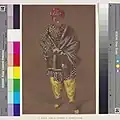Gakhars
The Gakhar (Punjabi: گاکھر) are a Punjabi clan found predominantly in the Jhelum District and Gujranwala District in Punjab, Pakistan.[1] The Gakhars now predominantly follow Islam after conversion from Hinduism during the Islamic rule of north India.[2][3][4]
| Gakhars | |
|---|---|
| Jāti | Rajput |
| Religions | |
| Languages | Punjabi |
| Country | Pakistan |
| Region | Punjab |
| Ethnicity | Punjabi |
Medieval history
The Gakhars had engaged in a long-running struggle for sovereignty over the Salt Range.[5] After the arrival of Muhammad of Ghor to medieval India, the Gakhars converted from Hinduism to Islam.[2]
The history of this region (the Salt Range) from the thirteenth century onward had been a sickening record of wars between various dominant landowning and ruling clans of Punjabi Muslims including the Janjuas, Gakhars, Thathals and Bhattis for political ascendancy.[6][7]
 Kamal Khan Ghakkar defeats Sultan Adam Ghakkar
Kamal Khan Ghakkar defeats Sultan Adam Ghakkar Rajah Ali Gour, a Ghakkar chief
Rajah Ali Gour, a Ghakkar chief
18th century
_with_cities.png.webp)
In the early 18th century, Gakhars gained independence from Mughals. They controlled major regions of Potohar between Jhelum and Indus, including Rawalpindi, Pharwala, Gujar Khan, Kahuta, Fatehjang and Rohtas.[8] The notable Gakhar chief Muqarrab Khan conquered cities of Gujrat and Jhelum in 1740.[9] He issued his own coins in which he claimed to be ruler of tract between Attock and Chenab.[9] He defeated the Yusafzai Afghans and Jang Kuli Khan of Khattak and overran as far north as Bhimber.[9] However, the Bhangi misl under Sardar Milka Singh forced him to give up control of Gujarat in 1765 and he returned to Jehlum.[9] In 1769 he was treacherously captured and put to death by a rival chief, Himmat Khan of Bugial clan. Ultimately Sikhs conquered Rawalpindi too in 1767 and Gakhars were left with only Phurwala and Jhelum under their control.[9] Muqarrab's son succeeded to his dominions, until Jhelum (1810) and Pharwala (1818) fell to the Ranjit Singh's invasions.[9]
See also
- Sarang Gakhar, Chief of Gakhars
- List of Punjabi tribes
- Gakhar Mandi
References
- Van Donzel, E. J., ed. (1994). Islamic Desk Reference. BRILL. p. 106. ISBN 978-9-00409-738-4.
- Gandhi, Surjit Singh (2007). History of Sikh Gurus Retold: 1469-1606 C.E. Atlantic Publishers. p. 3. ISBN 978-81-269-0857-8.
The story of most of the Gakhars is that they conquered Kashmir and ruled in that region for many generations but were eventually driven back to Kabul whence they entered the Punjab. They professed the Hindu faith and were converted to Islam, probably after the Ghori rule.
- Singha, Atara (1976). Socio-cultural Impact of Islam on India. Panjab University. p. 46.
After this period, we do not hear of any Hindu Gakhars or Khokhars, for during the next two or three centuries they had all come to accept Islam.
- Chandra, Satish (2006). Medieval India: From Sultanat to the Mughals. Vol. 2 (Revised, 2nd ed.). Har-Anand Publications. p. 45. ISBN 978-8-12411-066-9.
- Journal of the Pakistan Historical Society, Volume 54, Issues 1-2. Pakistan Historical Society. 2006.
- Bakshi, S. R. (1995). Advanced History of Medieval India. Anmol Publ. p. 142. ISBN 9788174880284.
- Rajput Gotain
- Punjab District Gazetteers: Rawalpindi District (v. 28-A). Haideri Press. 1909.
- Gazetteer of the Rawalpindi district. "Civil and Military Gazette" Press. 1895.
Further reading
- Gakkhar, A. S Bazmee Ansari, in Encyclopedia of Islam, 2nd ed.,Edited by J.H.Kramers et al., E.J Brill, Leiden, pp. 972–74.